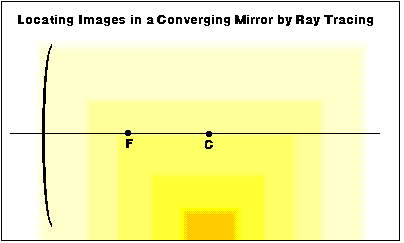Saturday, August 4, 2007
CONCAVE MIRRORSSuppose we place some object in front of a concave mirror. Light will bounce off the object in all directions if it is a diffuse reflector or be produced by it in all directions if it is a candle or a light bulb. Some of this light will strike the concave mirror and reflect from it according to the Law of Reflection. In order to locate any image produced by the mirror, you do not have to trace the paths of an arbitrary number of rays - the three rays discussed on the preceding page will do!
Suppose we place an object in front of a concave mirror, with the bottom of the object resting on the axis of the mirror, at a distance greater than the radius of curvature from the mirror. In order to locate the image:
1. Draw a ray that leaves the tip of the object, travels parallel to the axis, strikes the mirror, and is reflected through the focus of the mirror. Notice that if you were looking back along this ray toward the mirror, you would see the image (reflection) of the tip of the object in the mirror.
2. Draw a ray that leaves the tip of the object, travels through the focus of the mirror, strikes the mirror, and is reflected parallel to the axis. Again, if you would look back along this ray toward the mirror, you would see the image of the tip of the object in the mirror.
3. Draw a ray that passes through the center of curvature of the mirror and the tip of the object. It is reflected straight back along its original path.

If the object is closer than one focal length from the mirror, something surprising happens. As shown in the diagram, the object produces an upright, enlarged, virtual image behind the mirror! Converging mirrors can produce both real and virtual images!









